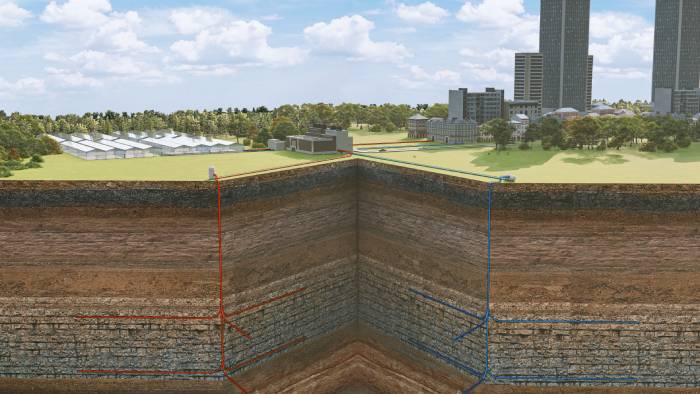
Now that we have to get rid of gas, alternative and sustainable energy sources are coming into the picture to heat our buildings. Geothermal energy, stored deep underground in the Netherlands, is one of the most promising alternatives. The City of Amsterdam, energy companies Eneco and Vattenfall are now working together with other parties to research new possible sources of geothermal heat. “It’s a sustainable, local source that does not require complex technologies or rare materials. We need to take advantage of it”, says David Bruhn, Professor of Geothermal Engineering at TU Delft.
Anyone who thinks of the cold winter months quickly thinks of (Russian) gas. But do we really need gas to stay warm? The Netherlands also has its own, sustainable heat source called ‘geothermal heat’ under its own feet, some 500 to 4000 meters deep. The hot water can, under suitable conditions, be pumped up and used to heat buildings connected to a heat network. Thus, in combination with other heat sources, it can contribute in the future to making the heat grid in the Netherlands more sustainable and independent.
Geothermal heat for Amsterdam
A new project was recently launched. The municipality of Amsterdam, the province of North Holland and heat companies Eneco and Vattenfall were jointly granted a permit by the Ministry of Economic Affairs to explore for geothermal heat in the Amsterdam region. This gave them the right for research in the licensed area into the suitability of the subsurface for extraction. The sights are set on 2030, by which time the parties want to offer the first geothermal heat to Amsterdam. It is not the first geothermal heat project to be launched in the Netherlands. It has already been extracted from the ground in, for instance, Westland, since 2007.
‘Geothermal energy the future’
And it is certainly not the last project either. Research commissioned by Energie Beheer Nederland (EBN) shows that in the future 2 to 2.5 million homes in the Netherlands could be connected to heat networks. Bruhn, who in addition to being a professor at TU Delft also works at Germany’s Fraunhofer Research Institute for Energy Infrastructures and Geothermal Energy, sees great potential in geothermal energy. “Besides being sustainable, it is also a very stable source of energy that, unlike heat from solar energy or wind, is available all year round,” he explains.
Moreover, the underground energy source gives the Netherlands a chance to pry itself away from countries like Russia, the professor continues. “It is our own, local source. Our low-hanging fruit. We simply don’t need other countries to supply us with heat. Let’s not waste it.”
A price tag
Still, there are certain considerations and drawbacks when it comes to geothermal heat. For example, as with any other type of drilling, groundwater contamination should be avoided. In addition, there is the price tag. Test drillings have to be done before the heat can be extracted, because subsurface properties and the sufficient availability of hot water are often not well known. And extra wells cost money. Building the heat network with insulated pipes is also not cheap, although that is not as big of a problem in densely populated areas. Bruhn: “Because there you often already have district heating. You can connect any kind of heat source to that, including geothermal. And if you have to build a network outside cities, I see it as a general investment in the community, just as we invest in our roads. We’re going to need it badly in the future anyway.”
In the end, the advantages of geothermal energy outweigh the disadvantages, Bruhn believes. If it is up to the professor, in the future it will be part of a heat network in which several heat sources come together. “Waste heat coming from data centers or the Port of Rotterdam, solar thermal heat and geothermal heat will all be a part of such a network.”
The bigger picture
Ultimately, more is needed than just the heat source itself to achieve a sustainable and affordable heat network in the Netherlands. As geothermal heat comes with a price tag, it is equally important to focus on the insulation of buildings in the Netherlands, Bruhn emphasizes.
“At the moment, the insulation standards of buildings in the Netherlands are very low. Heat has always been cheap, so nobody worried about it. In Germany, for example, it’s a completely different story. As a result, the standard there is much higher. We can’t get around it: sustainable heat is not going to be as cheap as it used to be when everything ran on gas. But with the right insulation measures, we can keep the costs down.”


